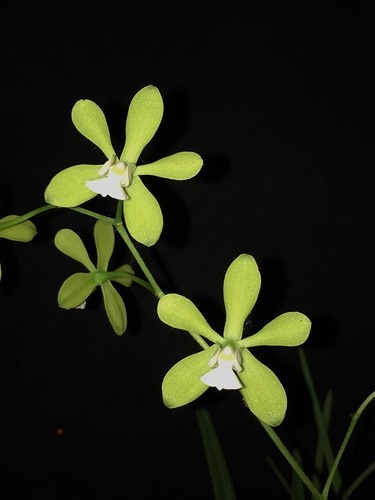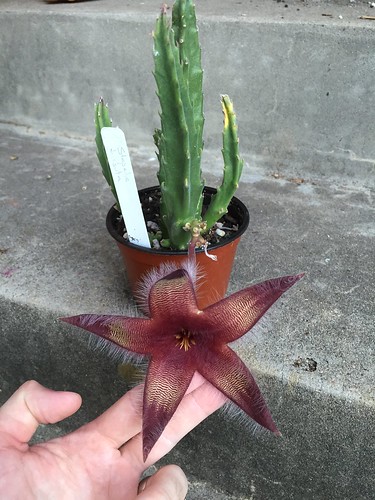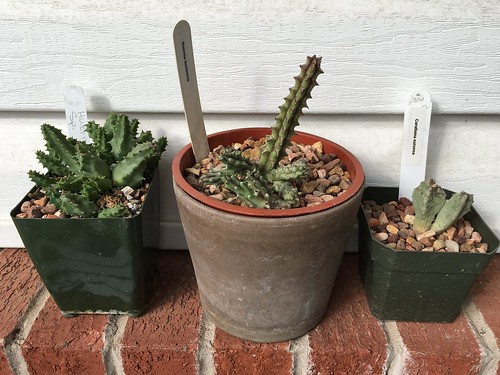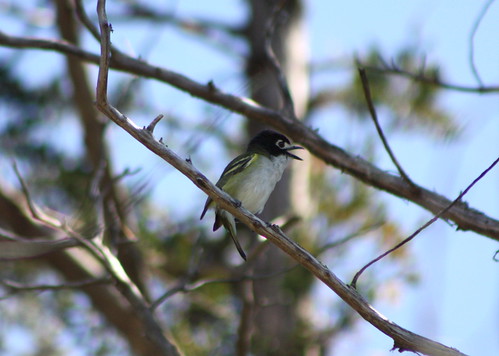Over time my collection of plants changes quite a bit. I buy new plants and other plants perish. At times I have tried to keep a comprehensive inventory, but my commitment to keep that inventory updated doesn't last and it gets to a point where it is so far behind I almost feel I need to start over.
 |
| E. tampensis v. alba |
 |
E. atrorubens?
This plant is labeled as E. guatemalensis, but that is not a recognized species. |
 |
E. tampensis
This plant FINALLY bloomed this year after having been in my collection for almost 6 years.
You'll notice it looks very similar to the first plant pictured in this post, except the first plant is lacking the pink,
since it is the "alba" variety. |
Recently I decided to inventory my plants in groups. I'm starting with my collection of
Encyclia, which is probably the genus of which I have the most plants. It's fun to post this list now because a lot of them are blooming or bloomed recently. It turns out I have more than 35
Encyclia plants, consisting of 22 species and10 known hybrids. (I know, 22 and 10 do not add up to 35, but I have a couple of duplicates and a couple of unknowns.)
Complete inventory of
Encyclia species:
- E. angustiloba
- E. aspera
- E. aspera
- E. belizensis **
- E. cordigera
- E. fowliei x fowliei 'Duncan'
- E. fucata
- E. gracilis
- E. guatemalensis * (may actually be E. atrorubens)
- E. hanburyi 'Mem. Merlin Rigley'
- E. kennedyi
- E. moebusii
- E. navanjapatensis
- E. patens
- E. phoenicea
- E. plicata **
- E. polybulbon
- E. ramonense 'Dr Pepper' **
- E. randii
- E. seidelii *
- E. tampensis *
- E. tampensis v. alba **
- E. unaensis
* indicates a species that has bloomed for me
** indicates a species that blooms regularly for me
I'm not a complete species purist, but I do concentrate on collecting species. Most of my hybrids are ones that I acquired in eBay auctions of multiple plants, and they were bundled with species I was interested in purchasing. In all I have 12 hybrid orchids that include Encyclia among the parents or grandparents.
Complete inventory of Encyclia hybrids:
- E. Faerie Glen (diota x mooreana) *
- E. John Brunton (mooreana x tampensis)
- E. phoenicea x tampensis
- E. tampensis v. alba 'Mendenhall' x plicata 'Cherokee'
- E. Cindy x dickinsoniana
- E. Orchid Jungle (alata x phoenicea)
- E. Gay Rabbit ([alata x cordigera] x cordigera) *
- E. (unidentified hybrid potted with Gay Rabbit) *
- E. (unidentified, possibly Grand Bahama)
- Epy. Mabel Kanda (E. cordigera x Epi. paniculatum) *
- Epc. Siam Jade (C. Penny Kuroda x Epc. Vienna Woods)
- Eplc. Pixie Charm (Lc. Pixie x E. alata)
* indicates a species that has bloomed for me
 |
Epy. Mabel Kanda
An intergeneric hybrid between Epidendrum and Encyclia.
I had to look up the correct abbreviation for this one in the RHS register. |
 |
E. Faerie Glen
This is a new plant that I just purchased at Santa Barbara Orchid Estate when I was in California in March. |
The hybrids are a mix bag of primary hybrids (a pure species crossed with another species), multi-generation hybrids, and even intergeneric (plants from different genus being crossed) hybrids. A lot of
Encyclia are used in orchid hybridization, especially crossing with
Cattleya,
Laelia, and
Epidendrum. You'll notice that Mabel Kanda hybrid is a cross of an
Encyclia and an
Epidendrum, while Siam Jade is a second generation intergeneric hybrid - a
Cattleya crossed with a hybrid of an
Encyclia and a
Cattleya.
 |
| Unidentified Encyclia hybrid |
The
Encyclia above is a mystery because it is in a pot labeled
Enc. Gay Rabbit. There are a lot of pseudobulbs in the pot and I have actually had two concurrent spikes with different flowers. One set of flowers has a white lip with some dark pink streaking (as shown in the photo), while the other flowers have a solid pink lip. I believe one is correctly labeled Gay Rabbit and the other (pictured above) may be something different. It is also possible that both are the same hybrid from the same parents and they are just displaying some of the variation expected for this hybrid.
I have one other plant that is missing a label. I am pretty certain it is an
Encyclia species or hybrid, because the pseudobulbs and growth habit match and it is sitting with all of my other
Encyclia. Based on my
past records, I think it may be
E. Grand Bahama (
tampensis x
plicata). I'm going to put that tentative label on it for now.
































